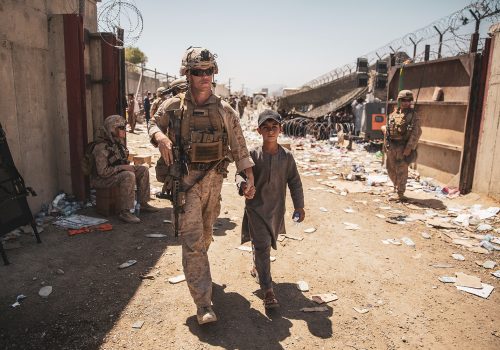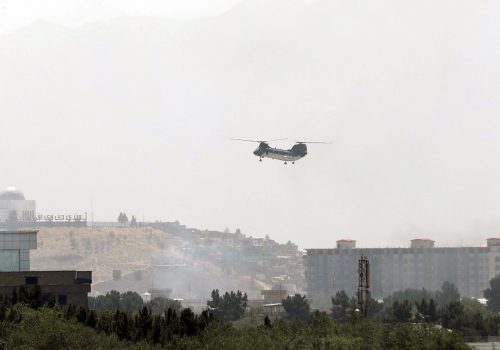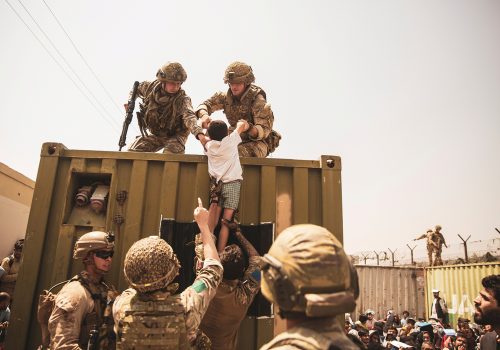PTSD is an endless war for veterans. The news from Afghanistan is making it worse.
The defeatist narrative dominating even domestic discussions about the US withdrawal from Afghanistan is going to have a tragic impact at home. The nation has not lost a uniformed service member in Afghanistan since February 8, 2020, but conditions now put service members and veterans at risk for debilitating mental health problems and suicide.
What was it all for? Was it worth it? Why did we bother? These questions are triggering post-traumatic stress disorder (PTSD) in our men and women who served in Afghanistan. Many of them returned home years ago. Some have sought treatment for PTSD and were on a road to recovery. The realities of the withdrawal and its framing as a defeat are setting that recovery back.
The risk of not addressing this issue is potentially deadly, as statistics from before the withdrawal illustrate. Despite the US troop presence in Afghanistan gradually scaling back to roughly 2.5 percent of its peak, suicide rates among troops and vets were at some of their highest in 2018, 2019, and 2020. The trajectory is alarming. Public discourse about a US defeat and twenty years of failure are making it worse.
Stuck points
The Department of Defense is cognizant of the disheartening frequency of veteran suicide as a result of PTSD.
The budget of the Department of Veterans Affairs has quintupled since the start of US military operations in Afghanistan, with mental health treatments and suicide prevention programs listed as priorities, albeit in the “other” category. In July at Eielson Air Base in Alaska, Secretary of Defense Lloyd Austin underscored that “one loss by suicide is too many and while we’re working hard on this problem, we have a lot more to do.”
Following the imminent end of US military operations in Afghanistan, we should expect a new spike in PTSD. The scenes of chaos in Kabul and of unchallenged Taliban seizures of power across the country compound the narrative that the US failed. Photographs of the Taliban in salvaged US military uniforms and gear, and stories about the abandonment of Afghan interpreters and others who supported American units evoke frustration and sadness among vets. Comparisons to the US pullout from Saigon and European leaders accusing the United States of “weakening NATO” further degrade the resilience of American veterans.
These narratives, unchallenged by opposing interpretations, can trigger what psychologists call stuck points. These are thoughts or beliefs a person has about the trauma they experienced that keeps them mentally and emotionally mired in it. A stuck point often manifests in the form of a thought that “If I had done X, the trauma would not have happened,” or “I should have done more in this situation.”
Dr. Dustin Kieschnick, an associate director of research at University of California San Francisco Medical Center, tells me in an interview that stuck points tend to be specific and exclude big-picture facts, like the limits to someone’s control over a quickly unfolding, traumatic event or scientific facts, like a body’s automated survival reactions. Thus, he says, canned narratives play right into stuck points by characterizing complex events in narrow, overly simplified terms that reinforce a person’s interpretation of the trauma and cripple processing of it. Kieschnick points to veterans of the Vietnam War, the population of vets with the highest suicide rate, as an example of how stuck points become lethal when compounded by public narratives of failure.
Part of building resilience among troops is equipping them with an understanding of the larger mission, the US national strategic interest or the moral imperative that necessitates the expenditure of US blood and treasure in a foreign land. Each geographic combatant commander, component commander, and battlefield commander issues guidance to all troops under their direction that is equivalent to a corporate mission statement. These short “commander’s intent” or “why we fight” statements provide service members with the overarching objectives their work supports.
Back home, military men and women struggling with what they saw and experienced while deployed are disconnected from that top-level intent. For them, the withdrawal from Afghanistan is a poignant and painful reminder of objectives unmet.
Failure to communicate
Media and communications narratives can trigger PTSD symptoms, Kieschnick explains, as seen when Christine Blasey Ford testified in 2018 about sexual assault allegations against US Supreme Court nominee Brett Kavanaugh—triggering traumatic memories for many women. Further, negative or conflict-laden narratives can have a significant effect, as seen in the recent spate of suicides among US Capitol Police after the January 6 insurrection.
From the start, planning for the Afghanistan withdrawal should have included strategic communications to highlight to active-duty military and vets—and to Americans broadly—the successes of US operations in Afghanistan. That way, service members could reconnect with the purpose of their service and derive a sense of accomplishment from it before the drawdown was announced.
The proof points were available. According to Human Rights Watch, 37 percent of adolescent Afghan girls could read as of 2017. Regardless of how draconian the Taliban remains or becomes, these girls will retain this invaluable life skill, made possible by twenty years of US troops and nongovernmental organizations enabling girls to attend school. Success in reducing infant mortality is another: though it typically increases in times of war, there has been a 50 percent decrease in infant mortality since the United States went into Afghanistan. This is the kind of statistic public health organizations dream about but rarely achieve. Hearing about this data could have armed vets against the onslaught of failure rhetoric.
In 2001 a cohort of men and women were commissioned into the military to plan and join the war in Afghanistan. That cohort is eligible to retire this year, having spent an entire career devoted to the war effort in Afghanistan or giving up resources in their own portfolios to support it. More than 775,000 troops have deployed to Afghanistan, many of them more than once. Crunch that number with the Department of Veterans Affairs statistic that vets are 1.5 times more likely to commit suicide than the general population, and the concern that a spike in PTSD among Afghanistan vets could take lives is very real.
‘Sacred obligation’
Two years ago, then presidential candidate Joe Biden told a town hall that there are “more suicides per month in the US military, returning vets, than people killed in action, by a long shot.” Indeed, a recent study published by Brown University and Boston University found that more than 30,000 active duty personnel and veterans of the post-9/11 wars have died by suicide, compared to about 7,000 combat deaths.
On the campaign trail, “The Biden Plan to Keep Our Sacred Obligation to Our Veterans” set the expectation that Biden as president would “ensure a multifaceted, substantive, and sustained commitment that addresses this as the public health emergency that it is.” The plan promised that a Biden administration would work “to ultimately end the suicide crisis among veterans.” Unfortunately, the lack of planning for the withdrawal’s impact on vets may exacerbate the suicide crisis.
Perhaps Biden’s political consultants assessed that American voters, weary with the “endless war” in Afghanistan, just wanted the funding and deployments to stop, victory or no victory. But of all the difficult domestic lessons the administration is learning through the withdrawal, this one could have costs beyond the polls.
It’s time to dust off that “Sacred Obligation” plan and double-time the implementation. The Afghanistan mission may be ending, but for American veterans, the war remains endless.
Kirsten Fontenrose is the director of the Scowcroft Middle East Security Initiative at the Atlantic Council and a former National Security Council senior director.
Further reading
Image: Mark Hoffmann reaches to adjust a dog tag as part of the Iraq and Afghanistan Fallen Veterans Memorial Wednesday, Aug. 18, 2021, at Lee Peterson Tree Farm's U-Pick Apple Orchard near Becker. Hoffman and his wife Linda created the memorial to honor soldiers killed in the conflicts. It currently contains about 5,500 memorial dog tags with the name, branch, age, date of death and country where each soldier died.Veteran Memorial 1


